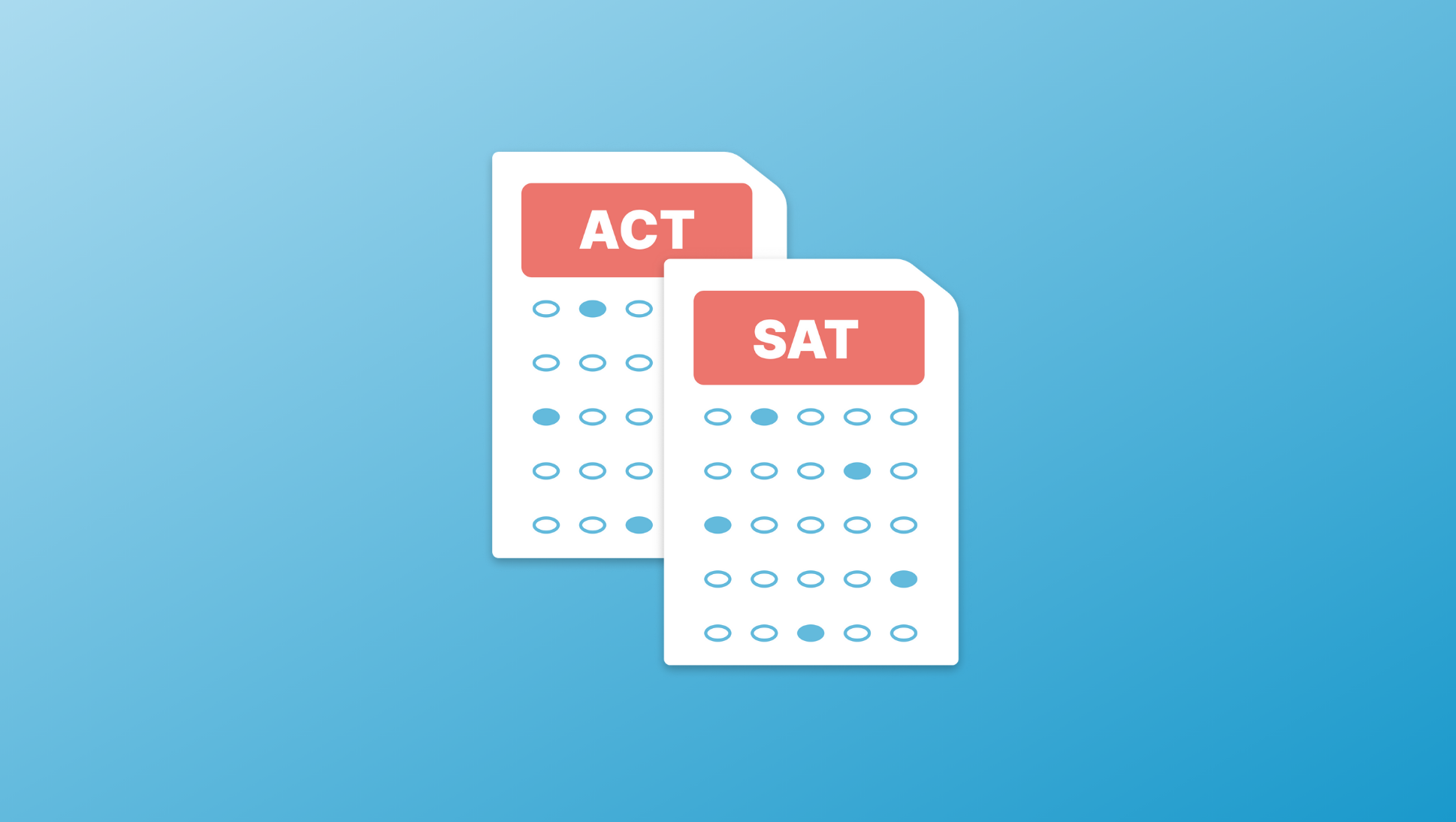Knowing whether to take the SAT or ACT can help relieve some of the stressors caused by the college admissions process. Students usually take the test that has been historically prevalent in their area or school.
In the past, the SAT was typically a coastal test, predominant in the East and West Coast regions, while the ACT was more often taken in the middle of the country. The fact is, however, that every college and university in the country accepts both tests.
Does that mean that you should take both tests? Not necessarily.
Read on for more guidance!
The History of the ACT and SAT
With the release of the new SAT in March of 2016, the College Board closed the gap on many of the significant differences between the SAT and the ACT, which on the surface makes the 2 tests seem pretty darn similar.
This year, the SAT went digital, while the ACT is still a paper test.
What's covered on the ACT and SAT?
Both tests now have 4 sections plus an optional essay component. However, be aware that the essay is not optional for all colleges. If you're unsure of where you will apply, be sure to take the essay portion. If you have a list of schools, check each school’s essay requirements. Some schools may not accept your SAT or ACT scores if you did not take the essay section.
- Both tests have questions that ask you to interpret graphs. The SAT has graphs and charts throughout all sections, while the ACT includes them on the Science and Math sections
- A student will NOT lose points for incorrect answers on either test, so making an educated guess on both tests is encouraged
- Neither test has a vocabulary section nor do they test esoteric vocabulary words anymore
- The digital SAT takes about 3 hours to complete including breaks, and the ACT takes about 4 hours including breaks (3.5 hours without the essay portion)
Although the tests may be more similar than in the past, there are still significant differences, and these differences may help you determine which test is better for you. While there are many charts available that give a general overview of the 2 tests, we'd like to dig a little deeper to help you understand the content and approach of each test so that you can make an informed decision.
The ACT
Pros of the ACT
- The English Section focuses more on grammar and punctuation. By learning the rules of the following topics, you should see an increase in your score:
- The Math Section tests a wider variety of Algebra I, Geometry, Statistics, and Algebra II skills, but the depth of knowledge for each skill is not as demanding
- Although the last 10 questions out of 60 are the most difficult and may test trigonometry, logarithms, and matrices, most students only need to focus on the first 50 questions to do well on the test
- For example, by answering 45 of the 60 questions correctly, you should score around a 29/36, which is equivalent to approximately 1330 to 1350 on the SAT—more than enough for the majority of schools in the country
- The passages in the Reading Section tend to be less difficult and more straightforward than those on the SAT. Since the passages are relatively easier, the questions usually feel less intimidating
- For students requiring accommodations for a disability, the ACT is often the best choice because of the way in which students are allowed to use their extended time. The ACT allows for self-pacing, so students are given 6 hours to take the test with the essay, and 5 hours without the essay. Within that time frame, they can use as much or as little time per section as they need. This flexibility is a huge bonus for students with extended time who are taking the ACT, as they might need more time in one area over another
- You can find free ACT test prep on the ACT website
Cons of the ACT
- Without a doubt, the biggest drawback to the ACT is the time constraints for several of the sections. If you struggle with timing in school and do not have testing accommodations as a result of an IEP or a 504 Plan, then the ACT might be difficult for you to get through in the time given
- The ACT Reading Section may present the most difficulty for students who are a bit more methodical and spend more time processing information
- The students have 8 minutes and 45 seconds to read a passage of about 100 lines and answer 10 questions
- The reading test section includes 4 passages with corresponding questions (40 in total) that need to be answered in 35 minutes
- Another potential negative to the ACT is the Science section, which does not necessarily test the science that the students learn in school, such as biology, physics, or chemistry. Instead, the science section tests your ability to read and interpret data. Before deciding that the science section will be too difficult, take a practice test and see how you do on it. You may surprise yourself. When taking the Science section, read and understand the meaning and/or relationship of the data presented before trying to answer the questions
The SAT
Pros of the SAT
- The SAT allows more time per question on each section than the ACT; however, you might need the additional time, since some of the SAT questions are more complex
- The charts and graphs on the SAT, although spread out over all 4 sections, tend to be easier than the Science section on the ACT. So, if you really struggle with the ACT Science section, the SAT might be better for you
- The Writing and Language section focuses less on punctuation and more on the way language is used within the context of a sentence. Plus, the Reading and Writing sections are now combined, and have shorter passages, helping to reduce the number of questions
- The College Board offers 8 free SAT practice tests with detailed explanations to every question on its website and has partnered with Khan Academy to offer free SAT prep to all students
- On the new digital SAT, you can use a calculator for all Math questions
Cons of the SAT
- While the Math Sections test less topics, the depth of knowledge must be deeper for the math concepts that are covered. You need to have a strong understanding of algebra and data analysis. In addition, the SAT math questions are often a bit more complex and require more steps to answer
- Another potential drawback of the Math Sections is that they both end with open-ended or grid-in questions, so you will not be provided with 4 multiple choice answers to plug back into the problem or to use for guessing, if needed
- Since the Reading Section on the SAT has at least 1 passage that was written over 100 years ago, it may contain a style and language that most of today’s students are not familiar with reading
- The Writing and Language Arts Section of the SAT assesses more usage questions than the ACT’s English section. Although the SAT no longer contains vocabulary sections, it now tests common words that are often confused. Some examples include the correct usage of “affect or effect;” how to use “outdo, outweigh, or outperform;” and when to use “of, for, or from”
So...what should I do?
We don't recommend simply adding up the pros and cons of each test and deciding what to do! Instead, begin by taking a practice or diagnostic test of both the ACT and SAT to determine which test is better for you.
Choose the test that is better suited for you, and then focus your time and attention on that specific test.
If you’ve taken the PSAT or PreACT in October, you can use these scores as solid predictors of how you will perform on the real tests. If you haven’t taken the PSAT or the PreACT, then you can print a free practice SAT test from CollegeBoard.org, or you can find a practice ACT at ACT.org. Then, rinse and repeat!
While it is important to do your best on either test to help your chances of getting into most schools and to increase the merit aid awarded to you, these tests are only one aspect of the admissions process.
For more resources that can help you prepare for the ACT and SAT, check out Scoir's partners.
This article was originally published on January 8, 2018. It was updated on October 31, 2023 for accuracy and comprehensiveness.
Abby deSilva is the Inbound Marketing Strategist at Scoir. She loves creating content and helping students find their dream college and career.

Abby deSilva
:
October 31, 2023



